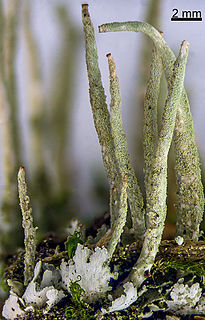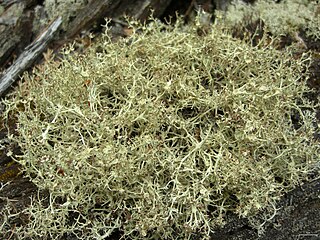
Cladonia is a genus of moss-like lichens in the family Cladoniaceae. They are the primary food source for reindeer/caribou. Cladonia species are of economic importance to reindeer-herders, such as the Sami in Scandinavia or the Nenets in Russia. Antibiotic compounds are extracted from some species to create antibiotic cream. The light green species Cladonia stellaris is used in flower decorations.

Cladonia asahinae, the pixie cup lichen or Asahina's cup lichen, is a species of cup lichen in the Cladoniaceae family. It grows on moss, particularly Chorisodontium aciphyllum, Polytrichum strictum, and Andreaea species. C. asahinae occurs in Europe, North America, and the southernmost part of South America. It also grows in the Antarctic.

Cladonia stellaris or the star-tipped cup lichen is an ecologically important species of cup lichen that forms continuous mats over large areas of the ground in boreal and arctic regions around the circumpolar north. The species is a preferred food source of reindeer and caribou during the winter months, and it has an important role in regulating nutrient cycling and soil microbiological communities. Like many other lichens, Cladonia stellaris is used by humans directly for its chemical properties, as many of the secondary metabolites are antimicrobial, but it also has the unique distinction of being harvested and sold as 'fake trees' for model train displays. It is also used as a sound absorber in interior design.

A podetium is the upright secondary thallus in Cladonia lichens. It is a hollow stalk extending from the primary thallus. Podetia can be pointed stalks, club like, cupped, or branched in shape and may or may not contain the ascocarp, the fruiting body, of the lichen. It is not considered part of the primary thallus as it is a fruiting structure for reproduction.

Cladonia parasitica, commonly known as the fence-rail cladonia, fence-rail cup lichen or parasite club lichen, is a species of fruticose, cup lichen in the family Cladoniaceae. It was first described by Hoffmann in 1784 under the name Lichen parasiticus, until he reclassified it under the genus Cladonia in 1795.

Cladonia amaurocraea, commonly known as the quill lichen or the quill cup lichen, is a species of fruticose, cup lichen in the Cladoniaceae family.

Cladonia sobolescens, commonly known as the peg lichen, is a species of fruticose lichen. It is found in temperate eastern North America and East Asia.

Cladonia caespiticia is a widespread and common species of fruticose, cup lichen in the family Cladoniaceae. It was originally named Baeomyces caespiticius by German mycologist Christiaan Hendrik Persoon in 1794. Heinrich Gustav Flörke transferred it to the genus Cladonia in 1827. In North America, it is commonly known as the stubby-stalked Cladonia.

Cladonia coniocraea, commonly known as the common powderhorn or the powderhorn cup lichen, is a species of fruticose, cup lichen in the family Cladoniaceae. It was first described by Heinrich Gustav Flörke in 1821 under the name Cenomyce coniocraea, until Kurt Polycarp Joachim Sprengel reclassified it under the genus Cladonia in 1827.

Cladonia digitata, commonly known as the finger cup lichen, is a cup lichen species in the family Cladoniaceae.

Cladonia cornuta or the bighorn cup lichen is a species of fruticose, cup lichen in the family Cladoniaceae. It was first described as a new species by Swedish lichenologist Carl Linnaeus in his seminal 1753 work Species Plantarum. German biologist Georg Franz Hoffmann transferred it to the genus Cladonia in 1791. The lichen has a distribution that is circumpolar, boreal, and arctic. It has also been recorded from the Southern Hemisphere.

Cladonia gracilis or the smooth cup lichen is a species of fruticose, cup lichen in the family Cladoniaceae. It was first described as a new species by Carl Linnaeus in his 1753 work Species Plantarum. German botanist Carl Ludwig Willdenow transferred it to the genus Cladonia in 1787. In North America, it is known colloquially as the "smooth Cladonia".

Cladonia subulata is a species of fruticose, cup lichen in the family Cladoniaceae. It was first described as a new species by Swedish taxonomist Carl Linnaeus in 1753. It was transferred to the genus Cladonia by Friedrich Heinrich Wiggers in 1780. In North America, the lichen is colloquially known as the antlered powderhorn or antlered cup lichen.

Cladonia uncialis is a species of fruticose, cup lichen in the family Cladoniaceae. It was first described as a new species by Swedish taxonomist Carl Linnaeus in 1753. It was transferred to the genus Cladonia by Friedrich Heinrich Wiggers in 1780. In North America, the lichen is colloquially known as the thorn Cladonia or the thorn cup lichen.

Cladonia ecmocyna or the frosted cup lichen is a species of fruticose, cup lichen in the family Cladoniaceae. It was first scientifically described as a new species in 1810 by Swedish lichenologist Erik Acharius as Cenomyce ecmocyna. British botanist William Allport Leighton transferred it to the genus Cladonia in 1866. In North America, it is known colloquially as the "frosted cladonia".

Cladonia incrassata or the powder-foot British soldiers cup lichen is a species of cup lichen in the family Cladoniaceae. Found in Europe and North America, it was formally described as a new species in 1828 by German botanist Heinrich Gustav Flörke. A colloquial name for the lichen is "powder-foot British soldiers".

Cladonia leporina is a species of lichen in the family Cladoniaceae. It was described as a new species in 1831 by Swedish mycologist Elias Magnus Fries. In North America, it is colloquially known as the "jester lichen". A sighting of a population of the lichen in New York (state) is the northernmost known occurrence of this species.

Cladonia pleurota is a species of fruticose, cup lichen in the family Cladoniaceae. It was first formally described as a new species by German lichenologist Heinrich Gustav Flörke in 1808 as Capitularia pleurota. Ludwig Emanuel Schaerer transferred it to the genus Cladonia in 1850. In North America, it is known colloquially as the red-fruited pixie cup or the red-fruited cup lichen.

Cladonia apodocarpa, also known as the stalkless cladoniais or the stalkless cup lichen, is a species of cup lichen in the Cladoniaceae family. Found in North America, it was described as a new species by Charles Albert Robbins in 1925.

Cladonia rei, commonly known as the wand lichen, is a species of ground-dwelling, fruticose lichen in the family Cladoniaceae. It is a widely distributed species, having been reported from Africa, Asia, Australasia, Europe, and North America. It is identified by its slightly dirty-colored, rough-surfaced, slender podetia that grow up to 9 cm (3.5 in) tall. Diagnostic characters of the lichen include the continuously sorediate, green-and-brown-mottled, podetia that taper upward to a point, while chemically, it contains homosekikaic and sekikaic acids. Its reduced capacity to bioaccumulate toxic heavy metals from its surroundings, as well as its ability to switch photobiont partners, allows the lichen to colonize and survive highly polluted habitats. There are several other Cladonia species that are somewhat similar in appearance, but can be distinguished either by subtle differences in morphology, or by the secondary chemicals they contain.




















